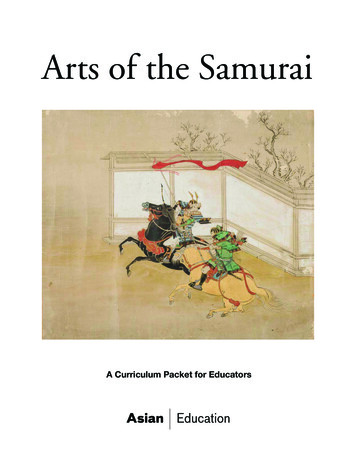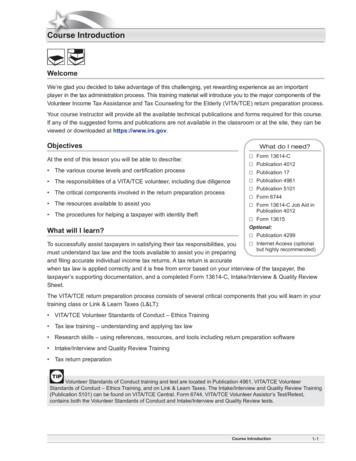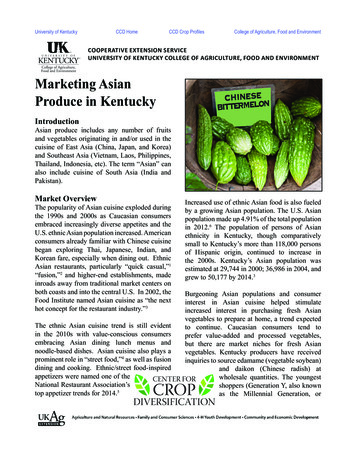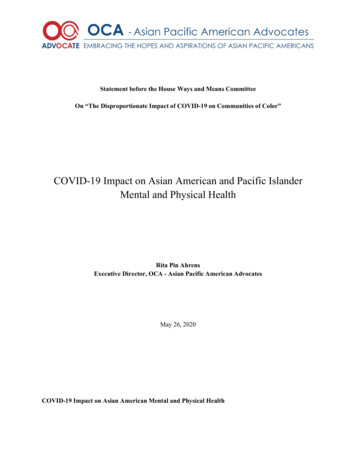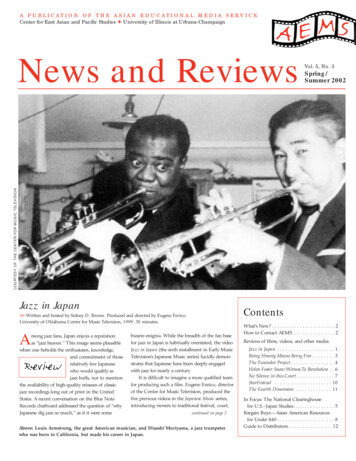
Transcription
A P U B L I C AT I O N O F T H E A S I A N E D U C AT I O N A L M E D I A S E RV I C ECenter for East Asian and Pacific Studies University of Illinois at Urbana-ChampaignA E MSSpring /Summer 2002COURTESY OF THE CENTER FOR MUSIC TELEVISIONNews and ReviewsVol. 5, No. 3Jazz in JapanContents Written and hosted by Sidney D. Brown. Produced and directed by Eugene Enrico.University of Oklahoma Center for Music Television, 1999. 30 minutes.Among jazz fans, Japan enjoys a reputationas “jazz heaven.” This image seems plausiblewhen one beholds the enthusiasm, knowledge,and commitment of thoserelatively few Japanesewho would qualify asjazz buffs, not to mentionthe availability of high-quality reissues of classicjazz recordings long out of print in the UnitedStates. A recent conversation on the Blue NoteRecords chatboard addressed the question of “whyJapanese dig jazz so much,” as if it were someReviewbizarre enigma. While the breadth of the fan basefor jazz in Japan is habitually overstated, the videoJazz in Japan (the sixth installment in Early MusicTelevision’s Japanese Music series) lucidly demonstrates that Japanese have been deeply engagedwith jazz for nearly a century.It is difficult to imagine a more qualified teamfor producing such a film. Eugene Enrico, directorof the Center for Music Television, produced thefive previous videos in the Japanese Music series,introducing viewers to traditional festival, court,continued on page 2Above: Louis Armstrong, the great American musician, and Hisashi Moriyama, a jazz trumpeterwho was born in California, but made his career in Japan.What’s New? . . . . . . . . . . . . . . . . . . . . . . . 2How to Contact AEMS . . . . . . . . . . . . . . . 2Reviews of films, videos, and other media:Jazz in Japan . . . . . . . . . . . . . . . . . . . . . 1Being Hmong Means Being Free . . . . . . . . 3The Turandot Project . . . . . . . . . . . . . . . . 4Helen Foster Snow:Witness To Revolution . . 6No Silence in this Court . . . . . . . . . . . . . . 7StarFestival . . . . . . . . . . . . . . . . . . . . . 10The Fourth Dimension . . . . . . . . . . . . . 11In Focus: The National Clearinghousefor U.S.–Japan Studies . . . . . . . . . . . . . . . 5Bargain Buys—Asian American Resourcesfor Under 40 . . . . . . . . . . . . . . . . . . . . . 8Guide to Distributors . . . . . . . . . . . . . . . . 12
Asian Educational Media ServiceThe Asian Educational Media Service (AEMS) is a program of the Center for East Asian and Pacific Studiesat the University of Illinois at Urbana-Champaign.AEMS offers information about where to find audiovisual media resources for teaching and learning aboutAsia, and advice about which ones may best suit yourneeds. In addition to AEMS News and Reviews, published quarterly, services include a free call-in/write-inservice and a Web site. To add your name to our mailing list, request additional copies of the newsletter touse in workshops or to share with your colleagues, orask for help in locating resources, please contact us.AEMS is made possible by generous support fromThe Freeman Foundation and The Japan FoundationCenter for Global Partnership.For more information, contact:AEMS, Center for East Asian and Pacific StudiesUniversity of Illinois at Urbana-Champaign230 International Studies Building, MC-483910 South Fifth StreetChampaign, IL 61820Telephone: 1-888-828-AEMS (1-888-828-2367)or 217-265-0642Fax: 217-265-0641E-mail: aems@uiuc.eduWeb: http://www.aems.uiuc.eduAdvisory BoardBurnill Clark, President and C.E.O., KCTS TelevisionLucien Ellington, Editor, Education About Asia;UC Foundation Professor, University of Tennesseeat ChattanoogaRichard Gordon, Executive Producer, Long BowGroup, Inc.Peter Grilli, President, Japan Society of Boston, Inc.Karl G. Heider, Professor of Anthropology, Universityof South CarolinaEllen C.K. Johnson, Associate Professor, College ofDuPageLaurel Kendall, Curator, Asian Ethnographic Collections,American Museum of Natural History; AdjunctProfessor of Anthropology, Columbia UniversityMarianna McJimsey, Lecturer in History/Social StudiesEducation, The Colorado CollegeSharon Wheaton, C.E.O., E.T. Interactive MultimediaDiana Marston Wood, Associate Director, Asian StudiesProgram, University of PittsburghEditorial Board (Faculty and staff of the Universityof Illinois at Urbana-Champaign.)Nancy Abelmann, Associate Professor of Anthropologyand East Asian Languages and CulturesClark E. Cunningham, Professor Emeritus ofAnthropologyDavid M. Desser, Professor of Speech Communicationsand Director of Cinema StudiesRoberta H. Gumport, Assistant Director andOutreach Coordinator of the Center for East Asianand Pacific StudiesJacquetta Hill, Professor of Anthropology and ofEducational PsychologyBlair Kling, Professor Emeritus of HistoryGeorge T. Yu, Professor of Political Science and Directorof the Center for East Asian and Pacific StudiesStaffProgram Director: David W. PlathProgram Coordinator/Editor: Sarah I. BarbourAssistant Program Coordinator: Elizabeth CothenDESIGN: EVELYN C. SHAPIROWhat’s New?Iregret to report that Liz Cothen, Assistant Program Coordinator for AEMS, will be leaving us inAugust to go back to graduate school full-time. Since she started working for us in July 2000, Liz hasbeen an invaluable colleague. She has catalogued our library, made numerous improvements to our Website and database, and worked hard to raise AEMS’ profile among the K–12 community. News andReviews readers may know her best through her regular “Bargain Buys” column, the last of which appearsin this issue.Liz will be working toward a Masters degree in Library and Information Science with an emphasison school media. She plans to pursue a career in children’s librarianship at a public or school library. Weat AEMS and at the Center for East Asian and Pacific Studies wish her the best in her studies and willmiss her very much.Liz can be reached at 217-333-9597 or at cothen@uiuc.edu until August 20.New Teacher’s Guide for To tmKelly Long, Assistant Professor of History at Colorado State College, has written a teacher’s guide toZhang Yimou’s popular feature film, To Live. The film shows events in China from the 1940s to the1970s. The guide, which is aimed at high school level classes, provides historical background to the film,discussion questions, activities, and suggested readings.Spring/Summer IssueThis issue combines what would ordinarily be the Spring and Summer issues. The Fall News andReviews should be out in September and will be a special issue focusing on feature films.Address UpdatesMoving house? Changing jobs? Please be sure to let us know your new address. You can use theenclosed postcard (please note on it that this is a new address) or e-mail us at aems@uiuc.edu. Yourcooperation will ensure that you continue to receive News and Reviews on a timely basis and will helpAEMS save both postage and paper. —Sarah I. Barbour, EditorJazzcontinued from page 1and theater music genres. The indefatigableSidney Brown, emeritus professor of history atthe University of Oklahoma and an expert onthe Meiji oligarchy, pioneered Western-languagestudies of jazz in Japan over two decades ago.He has presented several conference papers onJapanese and Japanese American jazz history andmusicians, supplementing his reading of theJapanese literature on the subject with his ownoral history research. Excerpts of Professor Brown’sinterviews with performers such as MoriyamaHisashi and Charles Kikukawa appear throughoutJazz in Japan.Viewers of Ken Burns’ PBS documentaryJazz will find the narrative strategy and methodof presentation familiar: the story is propelled bya wealth of images (still photographs, album covers, promotional materials, etc.) and tasty anecdotes about eminent individual artists. Thedevelopment of jazz is traced from transoceanicluxury liners to occupied Shanghai, recording studios to dance halls, U.S. servicemen’s clubs tocabarets. The final third of the film spotlightsJapanese artists who gained recognition internationally. The narrative effectively ends with theOccupation, ignoring the post-1960 avant-gardemovement completely. There is thus little overlapbetween this film and Craig McTurk’s 1999 documentary Tokyo Blues: Jazz and Blues in Japan,which does have historical content but also a moreobvious interest in the contemporary scene.Having co-hosted previous Enrico productions, Brown is clearly comfortable onscreen:his presence is warm and engaging, though thoroughly professional. The visual presentation isskillful and engrossing, and the soundtrack is richwith original recordings by Japanese jazzers. TheFujika K–oji Quintet, a regular fixture at Tokyo’sBirdland, opens and closes the film with its silkysmooth swing.The major events of Japan’s tumultuoustwentieth century serve mostly as a backdrop inJazz in Japan, rarely intruding to shape the narrative’s content. My own approach has been to portray jazz as deeply implicated in the contentiousdiscussions regarding national identity, modernity,continued on next page
Being Hmong Means Being Free Hosted by Lia Vang. A NEWIST/CESA 7 Production. 2000. 60 minutes.institutions such as the police or courts. At schoolyoung people must cope with problems such asEnglish mastery and successful study, social relationships, and friendships and dating, as well asprejudice against minorities. They must learn tonavigate American life while also maintaining theirHmong sense of identity. The film focuses onthose who are doing this successfully in variousways, but allows them to speak about their problems and experiences. It also tells, briefly, the sadstory of one young man who was killed in a hatecrime. (That young people are succeeding in theiradaptation is reflected in the election in February,2002, of Mee Moua, a woman in St. Paul,Minnesota, who became the first Hmong electedto an American state senate.)A 108-page teacher’s guide provides details onsome themes of the video, suggested activitiesrelating to Hmong and to multi-cultural understanding, a bibliography, Web sites, the full scriptof the video, some Hmong folk tales and foodrecipes, and more information on the Vang familywho are highlighted in the video. continued from previous pagecultural authenticity, creativity, and sense of placein the world that shaped Japan’s modern history.Brown and Enrico rather depict jazz as a bridgethat spans cultural chasms with relative grace andease. “Jazz is the world’s music,” Brown declares,“one of the great cultural ties that binds theUnited States and Japan, as important as baseball.” It is a view that is neither uncommon norindefensible, but which risks obscuring importantand provocative problems in U.S.–Japan relationsif absorbed uncritically. The militant Islamicistrhetoric that culminated in the September 11thCOURTESY OF NEWIST/CESA 7Being Hmong Means Being Free documentssignificant aspects of the history, traditions,and culture of Hmong people and portrays a variety of issues in their difficult experiences as fightersfor the CIA in Laos, then as refugees after theVietnam War’s end in 1975, and finally as immigrants to the United States. It was produced byNortheastern Wisconsin In-School Telecommunications at the University of Wisconsin–Green Bayand Wisconsin Public Television, and is meant tofacilitate multi-cultural understanding. It is set primarily in Green Bay, Wisconsin. Hmong residentsare narrators and interviewees who chronicle activities and events in their lives. The video is hostedby a sophisticated Hmong high school student(she graduated in 2001) whose family is given particular attention, but it draws upon Hmong froma variety of backgrounds in telling its story. Thefilm, which is very well made, would be useful forhigh school and college audiences as well as adultcommunity groups.The Hmong are rather unique immigrantsin that they came as families via refugee campsin Thailand from a preliterate society practicinghill farming and animal keeping in the mountainsof Laos but resettled mainly in urban areas ofthe United States. (Some moved subsequently torural areas of Montana and California, butmany remain in cities such as Green Bay orMinneapolis–St. Paul.) The film focuses uponfamily life, and issues such as family solidarity,gender roles, the very difficult relationshipsbetween generations, rites of passage at marriageand death, religious life (both shamanic andChristian), and prejudice, harassment, and violence experienced at the hands of white residents.Though the people involved are in northernWisconsin, many of their experiences can be gen-Lia Vang, the 17-year-old host of Being HmongMeans Being Free.eralized to other parts of the country.The film will be of particular interest to students and their teachers as it deals with the problems faced by young people who must live in twoworlds, their Hmong-speaking households andtheir schools. Their parents know little or noEnglish, often have only periodic employment,relate little to non-Hmong people, and distrustterrorist attacks has sobered many to the causticresistance Americana encounters around the world.No doubt students in the post–9-11 era will have amuch less sanguine perspective on global culturalflows than that offered here. Jazz in Japan thus instigates, as we say in the trade, a “teachable moment.”Jazz in Japan will prove useful in high school–and college-level social studies or humanities coursesaddressing Japanese culture, popular music, globalization, and transnational cultural exchanges. Iwould like to see it marketed to jazz studies programs, as well, as a much-needed corrective to theparochialism of most jazz curricula. Clark Cunningham is Professor Emeritus ofAnthropology at the University of Illinois atUrbana-Champaign. He has been a long-timeAssociate of the Center for East Asian and PacificStudies and has served as its Director. He was alsoVice Chair of the Asian American StudiesCommittee. He took a D. Phil. at OxfordUniversity and has spent a number of years doingresearch and teaching in Thailand and Indonesia,and teaching about Southeast Asia and AsianAmericans at UIUC.Being Hmong Means Being Free is availablefrom NEWIST/CESA 7. Price is 50 for rentaland 190 for purchase. E. Taylor Atkins is author of Blue Nippon:Authenticating Jazz in Japan (Duke UniversityPress, 2001), co-author (with Katharine C.Purcell) of “Korean P’ansori and the Blues:Art for Communal Healing” (East-WestConnections 2: March 2002), and editor of JazzPlanet: Transnational Studies of the “Sound ofSurprise” (forthcoming from the University Pressof Mississippi).Jazz in Japan is available from the Center forMusic Television. Price is 32.95.www.aems.uiuc.edu 3
HEATHER GREER / COURTESY OF ZEITGEIST FILMSChinese soldiers, lavishly costumed, are cast as extras for the Beijing production of Turandotstaged in the Forbidden City.The Turandot Project A film by Allan Miller. 2000. 87 minutes.In 1997, Zubin Mehta, the Indian-born formerconductor of the New York PhilharmonicOrchestra, and Zhang Yimou, the award-winningChinese film director (Raise the Red Lantern, ToLive, etc.) collaborated in staging the Italian opera,Turandot, in the Teatro Comunale de Firenze,Italy. A documentary video chronicling the stagingof this opera was produced by Allan Miller. In1998, a year after the Florence performance,Zubin Mehta and Zhang Yimou again collaborated to stage Turandot, this time at the ImperialPalace (also known as the Forbidden City) inChina. Again Allan Miller made a video documentary, entitled The Turandot Project, of this production which is the focus of this review.Turandot, an opera in three acts, was composed by Giacomo Puccini (1858–1924). Thestory is based on a Persian legend, which wassupposed to have taken place in Beijing, China,in legendary times. It focuses on a virgin princess,Turandot, who condemns her unsuccessful wooersto death if they fail to decipher three riddles.Eventually, Calaf, an unknown prince from a foreign country, succeeds in deciphering Turandot’sriddles and offers one of his own. Puccini alsoadds a character not included in the original story,the slave girl Liu, a somewhat enigmatic characterof Tartar origin who serves in Calaf ’s father’shousehold and is secretly in love with Calaf.The staging of the Turandot production inBeijing, as well as the making of the documentary,4 1-888-828-AEMSinvolved a huge cast of people representing manydifferent nationalities, types of professional training, and expertise. As nine consecutive performances were scheduled for the Beijingperformance, three groups of principal soloistswere used, with each group giving three performances each. The orchestra and chorus of MaggioMusicale Florentino who participated in this production had already rehearsed a year in advance inFlorence. Hundreds of dancers from the BeijingDance Academy were engaged to perform themany dance numbers. In order to fill out the vastperformance space, director Zhang Yimou engaged300 soldiers from Detachment 15 of BeijingDivision II as palace guards who performed a processional drum parade in the courtyard. The lighting team consisted of Italian and German lightingengineers and a large team of Chinese electricaltechnicians. Chinese designers, workmen, tailors,and embroiders were responsible for the production of sets, properties, and costumes respectively.Armies of translators of Chinese, Italian, andGerman languages were there to make cross-cultural communication possible. Finally, Chineseand Western cameramen produced the documentary video jointly.Occasionally the contents provide fascinatingglimpses of the cultural assumptions and expectations of the various participants of this project.Here are some interesting examples:(1) The documentary begins with commentsby Zubin Mehta relating to the conception andevolution of the Turandot production. Eventhrough Zhang had little previous knowledge ofWestern opera, Mehta justifies his selection of theChinese film director Zhang Yimou as his collaborator to direct the staging of Turandot by claimingthat as Zhang is Chinese, he would add “authenticity” to the production of a Chinese story. Sucha view could be thought to smack of essentialism,but Mehta’s quest for authenticity served as themajor impetus for the project.(2) Although Zubin Mehta claimed that theMing dynasty style costumes used for the production are authentic and therefore a perfect match tothe Ming architecture of the palace stage, to myeyes many of the so-called Ming style costumes aresimilar to the costumes used in Peking Opera,some of which are in Ming style, but many othersare an eclectic mixture of fancy costume styles,including some pseudo-Tang dynasty (618–906ad) costumes which probably derived from Tangtomb fresco paintings. In recent years they havebeen copied and appropriated by movies showingthe exotic past of China, and by productions ofmusical and dance spectacles to entertain foreigntourists.(3) An amusing set of scenes show therehearsal of the young soldiers recruited fromDetachment 15 to play the roles of palace guards.One scene shows the soldiers marching into theperforming arena carrying little folding stoolswhich they then sit on to be lectured by their captain, who admonishes them to take good care ofthe costumes and not to ogle the pretty dancers.In spite of this order, the camera catches many ofthem casting furtive glances at the young femaledancers. In another scene, someone relates thatthese young men were astonished upon hearingWestern operatic singing for the first time, sayingit sounded exactly like a cow mooing! Finally, wehear from the Detachment Commander thatnational pride motivated the Chinese governmentto participate in this project: a theme heard againand again in subsequent statements made byChinese from different walks of life. According tothe Commander: “We come from the people, andwe serve the people. [We are participating in thisproject because] we want our Chinese heritage andculture to march onto the world stage. An Armywithout culture is a stupid Army. We not onlyteach our soldiers how to fight, but we give themcultural and moral ideals as well, and that is theessence of a Socialist Army. We sing as we march,because we have culture!” Next we see the soldierssitting down, singing an army song in unisonunder a conductor. This juxtaposition of armysinging amidst a rehearsal of Turandot is a startlingcultural encounter.continued on next page
The National Clearinghouse for U.S.–Japan Studiesin focusFunded by the JapanFoundation Center forGlobal Partnership, theNational Clearinghouse for U.S.–Japan Studies at IndianaUniversity specializes in providing educationalinformation about Japan at little or no cost toK–12 students, teachers, specialists, and curriculum developers.HEATHER GREER /COURTESY OF ZEITGEIST FILMSNew PublicationsThe Clearinghouse publishes the Japan Digestseries, Internet Guides, and an annual newsletter.Japan Digests are two-page summaries covering avariety of topics related to Japan and U.S.–Japanrelations. Two recent Japan Digests are “ExaminingJapan’s History Textbook Controversies” and“Understanding Okinawa’s Role in the U.S.–JapanSecurity Arrangement.” Internet Guides are handyreferences to online resources. Recent titles include“Japan in World History,” “Japanese Festivals andNational Holidays,” and “Japan’s Imperial Family.”All these publications are available online andpaper copies are available at no cost.Enhanced DatabasesThe U.S.–Japan Database is a bibliographicdatabase of educational materials including curriculum units, teaching guides, abstracts of articlesfrom journals like Education about Asia, andreference resources. The Clearinghouse also maintains a searchable database of lesson plans. Boththe Lesson Plan Database and the U.S.–JapanDatabase are searchable online at the Clearinghouse Web site. In addition, staff is available toconduct custom searches for educators free ofcharge.Expanded ServicesThe Clearinghouse site on the World WideWeb provides an access point to Clearinghousepublications and databases, as well as a gateway tonumerous other resources such as AEMS, SPICE(Stanford Program for International and CrossCultural Education), and local JapaneseConsulates.The Clearinghouse also prepares complimentary Information Packets which include print versions of most Japan Digests and Internet Guides,continued from previous page(4) In another revealing scene concerningChinese national pride, we see Zhang Yimou chatting with members of the Chinese productionteam. After exhorting them to do their best, hesays: “The performance [of Turandot] provides usChinese a chance to appear on the internationalstage together with the best of Western artists,and to show the world that [what we do here] canmatch their dedication, seriousness, and artisticexcellence. That is why I took on this task; I wantto raise the profile of the excellence of the Chinesecultural tradition to the world, so that we canachieve the international recognition that has longbeen overdue to us.”(5) Finally, I want to talk about one episodeshowing the clash and compromise betweenZhang Yimou and the famous Italian lightingengineer Guido Levi. More than any otherepisode, this one highlights the difficulty in international collaboration between artists from different cultures who carry different sets of culturalassumptions and expectations. After seeing thelighting arrangement by Levi, Zhang was unhappy, finding the lights too dim. Being a carrierof the Chinese stage tradition, Zhang wanted auniformly bright light to shine on the stage inorder to illuminate the brilliant costumes andheaddresses worn by the actors; being a specialistSharon Sweet, internationally renownedsoprano, stars as Princess Turandot in theBeijing production of Turandot.of contemporary Italian operatic lighting, Leviwanted dimmer lighting with different gradationsof illumination according to the requirement ofthe dramatic situation. In an interview from whichZhang Yimou was absent, Levi said bluntly thathe considered uniformly bright lighting a vulgarmonstrosity, and went on to say exactly what hethought of this production: “Today we are losingthe public that loves opera, so we have to look fora director with a [recognized] name. So we hire acinema director [to do the job]. Why? Becauseeveryone goes to the movies and not the opera,and that’s the main reason. However, the result isnot always.” but he did not finish the sentence.the newsletter, as well as information on a varietyof other Japan-related resources. InformationPackets are a perfect introduction to K–12 educational resources on Japan. Please note that educators are invited to order Packets for distribution atconferences, seminars, and workshops. National Clearinghouse for U.S.–Japan StudiesIndiana University2805 E. Tenth St., Suite 120Bloomington, IN 47408-2698(812) 855-3838 or (800) 266-3815http://www.indiana.edu/ japanjapan@indiana.eduIn the end, Levi gave in and compromised withgood humor. The documentary ends with scenesof the final performance and the approval of theaudience who rewarded Zubin Mehta and ZhangYimou with many rounds of applause.This documentary is best used as a lesson toteach cultural sensibility and international collaboration. However, the teacher should be prepared todo some preliminary research on the cultural andperforming traditions of the Chinese stage andthose of the Italian opera in order to make the lesson meaningful to students. Isabel Wong is Director of Overseas Projectsand Foreign Visitors and Assistant Professor ofMusicology at University of Illinois at UrbanaChampaign. Her publications and papers havedealt with aspects of Chinese musical theater, thehistory of Chinese musicology, the intellectual history of Chinese music in the twentieth century,music and politics in China, popular music inShanghai during the republican period, and musicof Chinese American communities.The Turandot Project is available from ZeitgeistFilms. University price is 195 for purchase and 150 for rental. The video will be available forpurchase on June 25, 2002.www.aems.uiuc.edu 5
COURTESY OF BRIGHAM YOUNG UNIVERSITY AND FILMAKERS LIBRARYHelen Foster Snow: Witness To Revolution Directed by Dodge Billingsley. Produced by Combat Films and KBYU Television. 2000. 57 minutes.Tclusion of the film answershe story of HelenThefilmcertainlya qualified no.Foster Snow as preThe focus of the filmsented in the documenrecognizesHelenisabrief period (1931–tary Helen Foster Snow:1940)in Helen’s life fromWitness To Revolution is aFosterSnow’sherearlytwenties (shesad one. The picture thatarrivesinShanghai as acomes across is of a fruscontributions.yet23-year-old)to her earlytrated woman who wasthirties,whichshe spentnever able to meet herthesearedownplayed.inChina.Thefilmis fairlyown expectations of hermeticulousinshowingself. The introduction ofhow the events of thesethe documentary sets theyears,fromtheChinesestudent movement to herwork up by asking the question: while Helenmarriage(atage25)toEdgarSnow, forced herFoster Snow’s travels to and within China impactintoaroleorpositionshehadnot originallyed her for the rest of her life, “would her workintendedtotakeup.Thisseemsto have been thehave any influence on history?” To which the con-6 1-888-828-AEMStheme of Helen’s life as presented in the film; awoman ever on the verge of a breakthrough butheld back by conflicts between her roles as anactivist and as a writer.The film certainly recognizes Helen FosterSnow’s contributions to both the Chinese revolution itself, the workers’ cooperatives she organized,and the field of Chinese history, yet these aredownplayed in a story that frequently focuses onher frustrations and failures regarding both herpersonal and public lives. While this is perhaps,and I would emphasize perhaps, a fair assessmentof her contributions, which do seem to have beenswept to the background of larger events and personalities, the documentary could have been aforce which revealed the significance of her workand writings and placed them in the foreground.This, however, is not what the documentary does.Rather, the work attempts to firmly contextualizeSnow and her efforts within both 1930s Chinaand her relationship with Edgar Snow. In thissense the work may be overly ambitious. In paringthese three elements (the revolutionary movement,Helen Snow’s work, and her failing relationshipwith Edgar) down to 56:46 minutes of footage, itseems inevitable that certain elements would haveto be emphasized over others. Unfortunately, itwas Helen’s real contributions which were, again,pushed to the background.As a classroom tool, Helen Foster Snow: WitnessTo Revolution would be difficult, but not impossible, to use. It is a documentary about Helen FosterSnow. It is not about China in the 1930s; rather itis about an ambitious American woman in Chinaduring this period. While there is a significantamount of archival footage and some explanationof the events that she was able to witness, theevents are not the focus of the film. The documentary itself could not be used as an introduction tothe period as the unfolding events are used only toexplain Helen Snow’s actions. The events themselves are only cursorily placed in the larger context of the chaotic political situation of the time.Viewers without some prior knowledge of thepolitical situation of China during this period willnot come away with a clear understanding andwill have a tough time understanding the background. Stephen Udry is Assistant Professor of History atCarthage College where he teaches courses onmodern Chinese and Japanese history as well ascourses on film in Asia. He is currently workingon a book on the shamanisms of the Manchus.Helen Foster Snow: Witness To Revolution isavailable from Filmakers Library.
Center for East Asian and Pacific Studies University of Illinois at Urbana-Champaign Spring/ Summer 2002 Vol. 5, No. 3 Jazz in Japan Written and hosted by Sidney D. Brown. Produced and directed by Eugene Enrico. University of Oklahoma Center for Music Television, 1999. 30 minutes. Above: Louis Armstrong, the great American musician, and .






